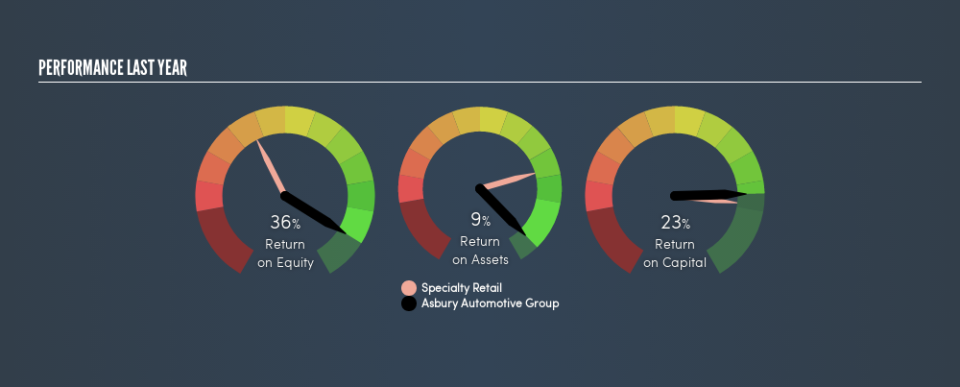Here's What Asbury Automotive Group, Inc.'s (NYSE:ABG) ROCE Can Tell Us

Want to participate in a research study? Help shape the future of investing tools and earn a $60 gift card!
Today we'll evaluate Asbury Automotive Group, Inc. (NYSE:ABG) to determine whether it could have potential as an investment idea. In particular, we'll consider its Return On Capital Employed (ROCE), as that can give us insight into how profitably the company is able to employ capital in its business.
First, we'll go over how we calculate ROCE. Next, we'll compare it to others in its industry. Finally, we'll look at how its current liabilities affect its ROCE.
Understanding Return On Capital Employed (ROCE)
ROCE measures the 'return' (pre-tax profit) a company generates from capital employed in its business. All else being equal, a better business will have a higher ROCE. Overall, it is a valuable metric that has its flaws. Author Edwin Whiting says to be careful when comparing the ROCE of different businesses, since 'No two businesses are exactly alike.'
So, How Do We Calculate ROCE?
The formula for calculating the return on capital employed is:
Return on Capital Employed = Earnings Before Interest and Tax (EBIT) ÷ (Total Assets - Current Liabilities)
Or for Asbury Automotive Group:
0.23 = US$315m ÷ (US$2.7b - US$1.3b) (Based on the trailing twelve months to December 2018.)
Therefore, Asbury Automotive Group has an ROCE of 23%.
See our latest analysis for Asbury Automotive Group
Does Asbury Automotive Group Have A Good ROCE?
ROCE can be useful when making comparisons, such as between similar companies. Asbury Automotive Group's ROCE appears to be substantially greater than the 13% average in the Specialty Retail industry. I think that's good to see, since it implies the company is better than other companies at making the most of its capital. Putting aside its position relative to its industry for now, in absolute terms, Asbury Automotive Group's ROCE is currently very good.
When considering this metric, keep in mind that it is backwards looking, and not necessarily predictive. ROCE can be deceptive for cyclical businesses, as returns can look incredible in boom times, and terribly low in downturns. ROCE is, after all, simply a snap shot of a single year. Future performance is what matters, and you can see analyst predictions in our free report on analyst forecasts for the company.
Do Asbury Automotive Group's Current Liabilities Skew Its ROCE?
Current liabilities include invoices, such as supplier payments, short-term debt, or a tax bill, that need to be paid within 12 months. The ROCE equation subtracts current liabilities from capital employed, so a company with a lot of current liabilities appears to have less capital employed, and a higher ROCE than otherwise. To check the impact of this, we calculate if a company has high current liabilities relative to its total assets.
Asbury Automotive Group has total liabilities of US$1.3b and total assets of US$2.7b. Therefore its current liabilities are equivalent to approximately 48% of its total assets. Asbury Automotive Group's ROCE is boosted somewhat by its middling amount of current liabilities.
What We Can Learn From Asbury Automotive Group's ROCE
Despite this, it reports a high ROCE, and may be worth investigating further. You might be able to find a better buy than Asbury Automotive Group. If you want a selection of possible winners, check out this free list of interesting companies that trade on a P/E below 20 (but have proven they can grow earnings).
I will like Asbury Automotive Group better if I see some big insider buys. While we wait, check out this free list of growing companies with considerable, recent, insider buying.
We aim to bring you long-term focused research analysis driven by fundamental data. Note that our analysis may not factor in the latest price-sensitive company announcements or qualitative material.
If you spot an error that warrants correction, please contact the editor at editorial-team@simplywallst.com. This article by Simply Wall St is general in nature. It does not constitute a recommendation to buy or sell any stock, and does not take account of your objectives, or your financial situation. Simply Wall St has no position in the stocks mentioned. Thank you for reading.

 Yahoo Finance
Yahoo Finance 
